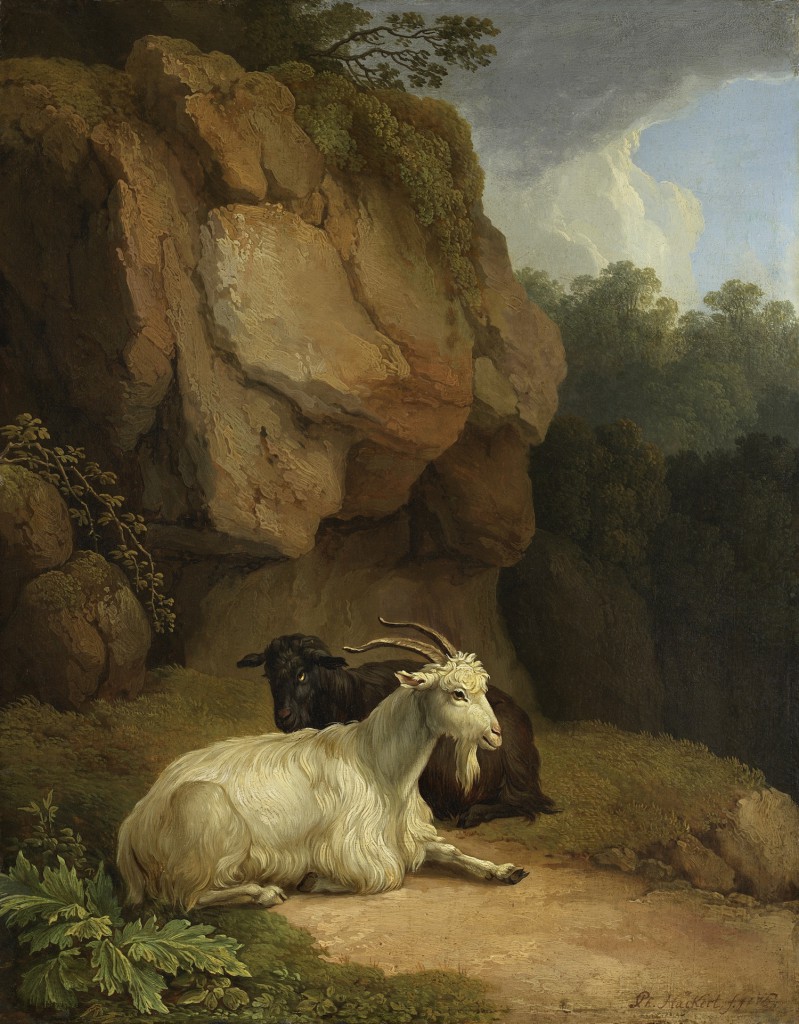Jakob Philipp Hackert (Prenzlau 1737 - 1807 San Piero di Careggi, Florence)
Two Goats on a Rocky Ledge, 1775
Oil on panel, 35.5 x 28 cm
Signed, dated and inscribed Ph. Hackert f 1775
Provenance:
Georg Schäfer Collection, Schweinfurt
Literature:
Claudia Nordhoff and Hans Reimer, Jakob Philipp Hackert (1737-1807), Verzeichnis seiner Werke, II, Berlin 1994, p.37, no. 92, fig. 38
This very fine, small panel painting can be dated to Hackert's Roman period. On his extensive exploration of the Campagna Romana he had ample opportunity to draw and paint from nature, capturing studies of goats, cattle, sheep and dogs.
The panel depicts two goats, one a white buck, the other a black female, lying beneath a craggy rock face. Trees are glimpsed at the right. The goat in the foreground is shown in profile to the right. The detail of execution and individualization, particularly in the portrayal of the buck, sets the work apart from other goat images that figure frequently in Hackert's work.[1] The rock face depicted behind the animals is handled in subtly modulated shades of brown, more clearly defined at the centre by the fall of light. The land falls away steeply at the right. The viewer's eye is led towards the filigree outline of silvery treetops and beneath them, dense foliage and a mass of rocks bathed in shadow.
The portrayal of animals preoccupied Hackert throughout his artistic career. He used them not simply as staffage to animate his landscapes but portrayed them in their own right with extraordinary skill and sensitivity. His portraiture of animals recalls the work of his contemporary, Johann Heinrich Wilhelm Tischbein, who was also working in Rome at about this time.
Jakob Philipp Hackert is generally considered one of the leading landscape painters of the early neoclassical period in Germany and Italy. He studied in Berlin, lived in Stockholm for a while and then settled in Paris in 1765. He was befriended by the engraver Johann Georg Wille and the celebrated landscape painter Claude-Joseph Vernet.[2]
He travelled to Rome in 1768 accompanied by his younger brother Johann Gottlieb. The architecture of the city and its classical ruins made a deep and lasting impression on both. Jakob Philipp Hackert rapidly established his reputation as a highly sought-after landscape painter. His friendship with Hofrat Konrad Friedrich von Reiffenstein, a dealer in works of art, led to his introduction to high society in Rome. Catherine the Great of Russia commissioned him to execute a series of battle pieces in 1770, an indication that Hackert already enjoyed an international reputation in his early years in Rome. Graf Rasumowsky, the Russian ambassador to the court in Naples, introduced him to Ferdinand IV in 1782. This led to regular commissions. Four years later he was appointed court painter. This secured him a regular income but still left him with time to complete other commissions. He regularly attended the brilliant Neapolitan court and met many of the famous foreign visitors on the Grand Tour. Johann Wolfgang von Goethe[3], for example, was a close friend.
[1] Hackert painted further images of goats in 1776 (for examples, see Nordhoff and Reimer, op. cit., nos. 96-8) and again in the period after 1800 (see Nordhoff and Reimer, op. cit., nos 298, 343 and 365). [2] Nordhoff and Reimer, op. cit., I, p.3. [3] Nordhoff and Reimer, op. cit., I, p.55.

